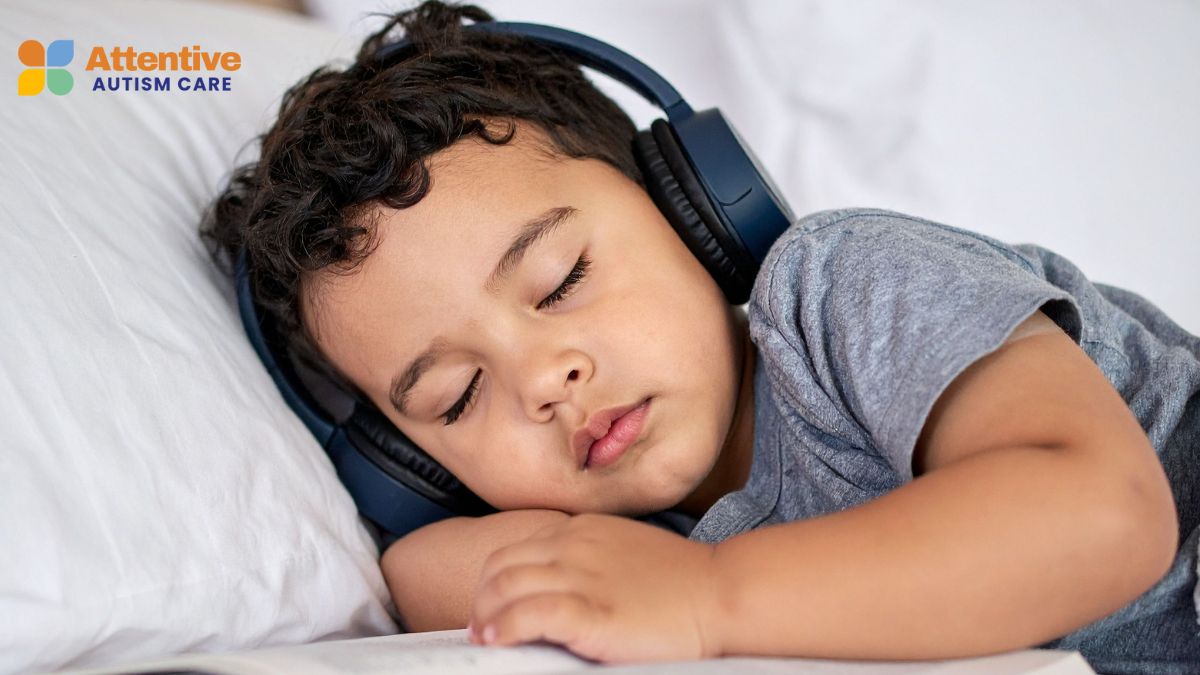Autism and Migraines/Headaches
Unraveling the Complex Link Between Autism and Migraines
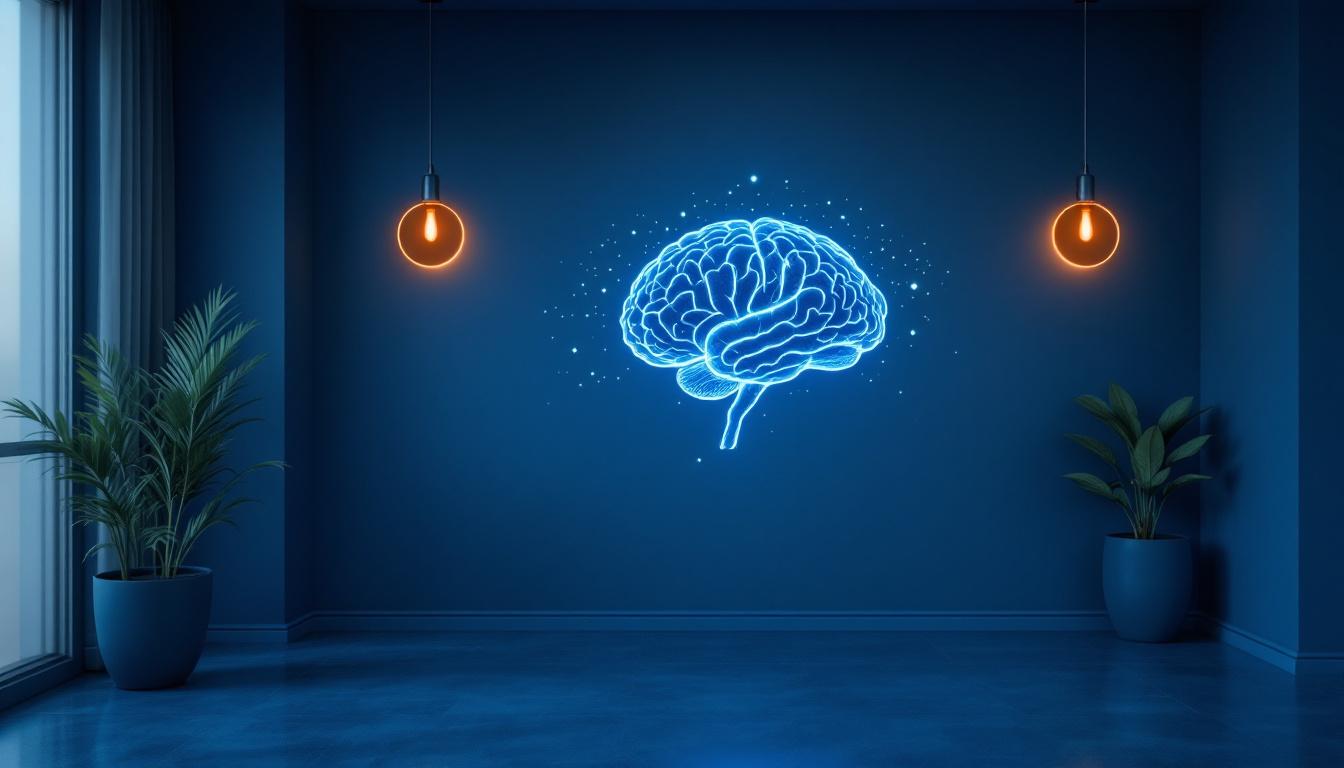
Understanding the Overlap Between Autism Spectrum Disorder and Migraines
Recent research reveals a compelling connection between autism spectrum disorder (ASD) and migraines, highlighting shared neurobiological mechanisms, genetic factors, and sensory processing abnormalities. This article explores the prevalence, underlying mechanisms, clinical features, and management strategies pertinent to autistic individuals suffering from migraines, aiming to foster awareness and improve care practices.
Prevalence and Epidemiological Evidence of Migraines in Autistic Individuals
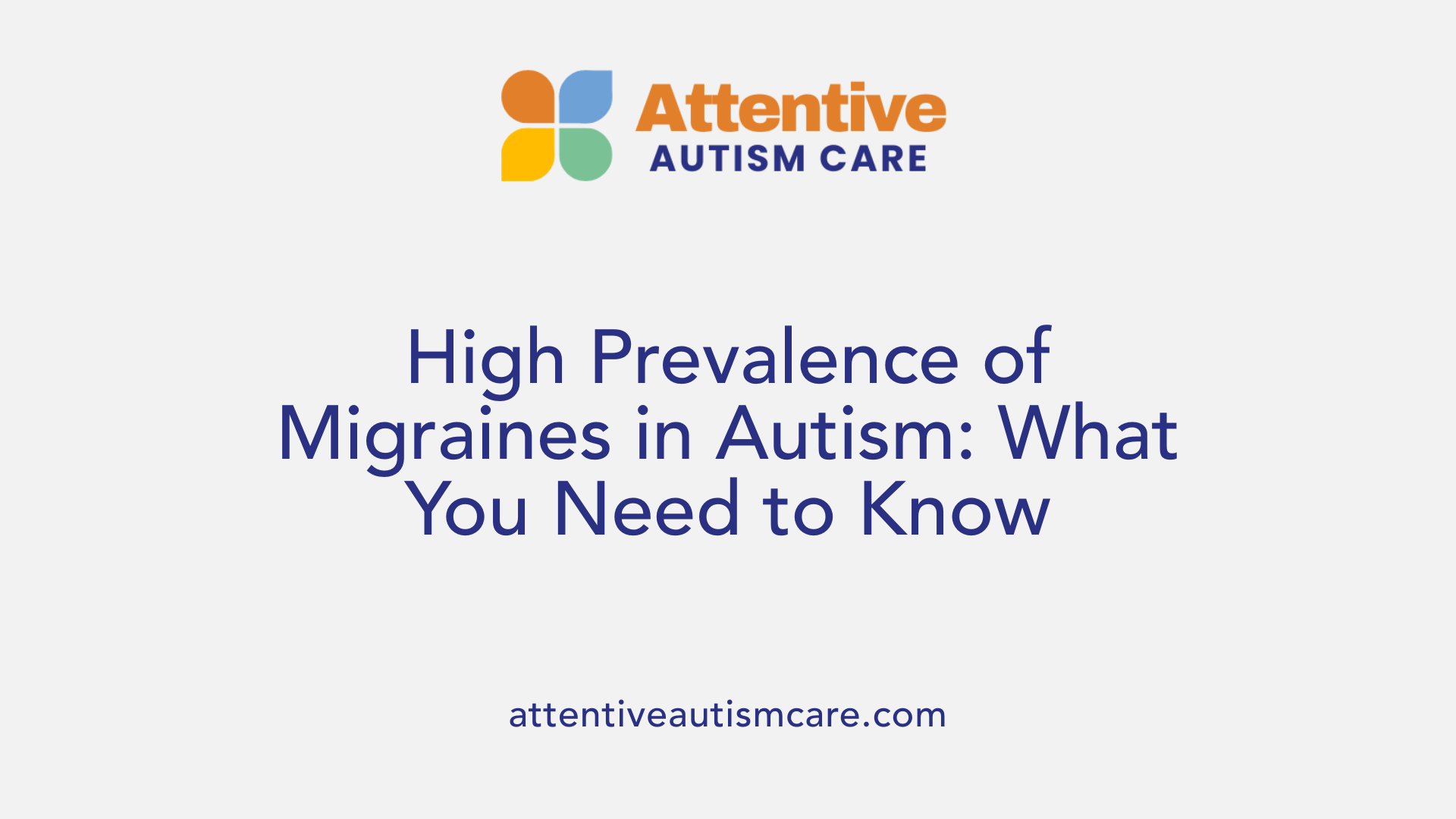
What is the association between autism and migraines?
Research indicates that individuals with autism spectrum disorder (ASD) are significantly more likely to experience migraines compared to neurotypical individuals. Studies report that the prevalence rates of migraines in autistic populations range from about 28.4% to over 61%, considerably higher than in the general pediatric and adult populations.
In children and adolescents with ASD, the occurrence of migraines is notably elevated. For example, a study examining medical records of autistic children found that approximately 61% experienced migraine headaches. Similarly, in adult autistic populations, rates of migraine have been reported around 42.7%, compared to about 20.5% in non-autistic adults.
This higher prevalence is supported by multiple factors. Neurological mechanisms such as alterations in serotonin levels, neurochemical imbalances, and genetic mutations affecting ion channels (like CACNA1A, SCN1A, and ATP1A2) are common to both autism and migraines.
Furthermore, sensory processing abnormalities are prevalent in ASD, with heightened responses to light, sound, and touch, which can trigger or exacerbate migraine episodes. Sleep disturbances and increased connectivity in certain brain regions like the thalamus also contribute to the susceptibility.
The overlap of these physiological and neurochemical pathways indicates a complex relationship, where shared genetic predispositions, immune system dysregulation involving neuroinflammation, and common sensory sensitivities all play roles.
Implications for health care
The high rate of migraines among autistic individuals underscores the importance of routine screening for headaches, especially in children and young adults with ASD. Early recognition and management of migraines can significantly improve quality of life. Healthcare providers should consider sensory sensitivities and behavioral changes as potential signs of underlying migraines. Tailored treatment strategies, including lifestyle modifications, behavioral therapies, and medications, are essential for comprehensive care.
Understanding this epidemiological link helps in developing targeted interventions and highlights the need for increased awareness among clinicians, caregivers, and patients about the risks and management of migraines in the autistic community.
Shared Genetic and Neurobiological Pathways Linking Autism and Migraines
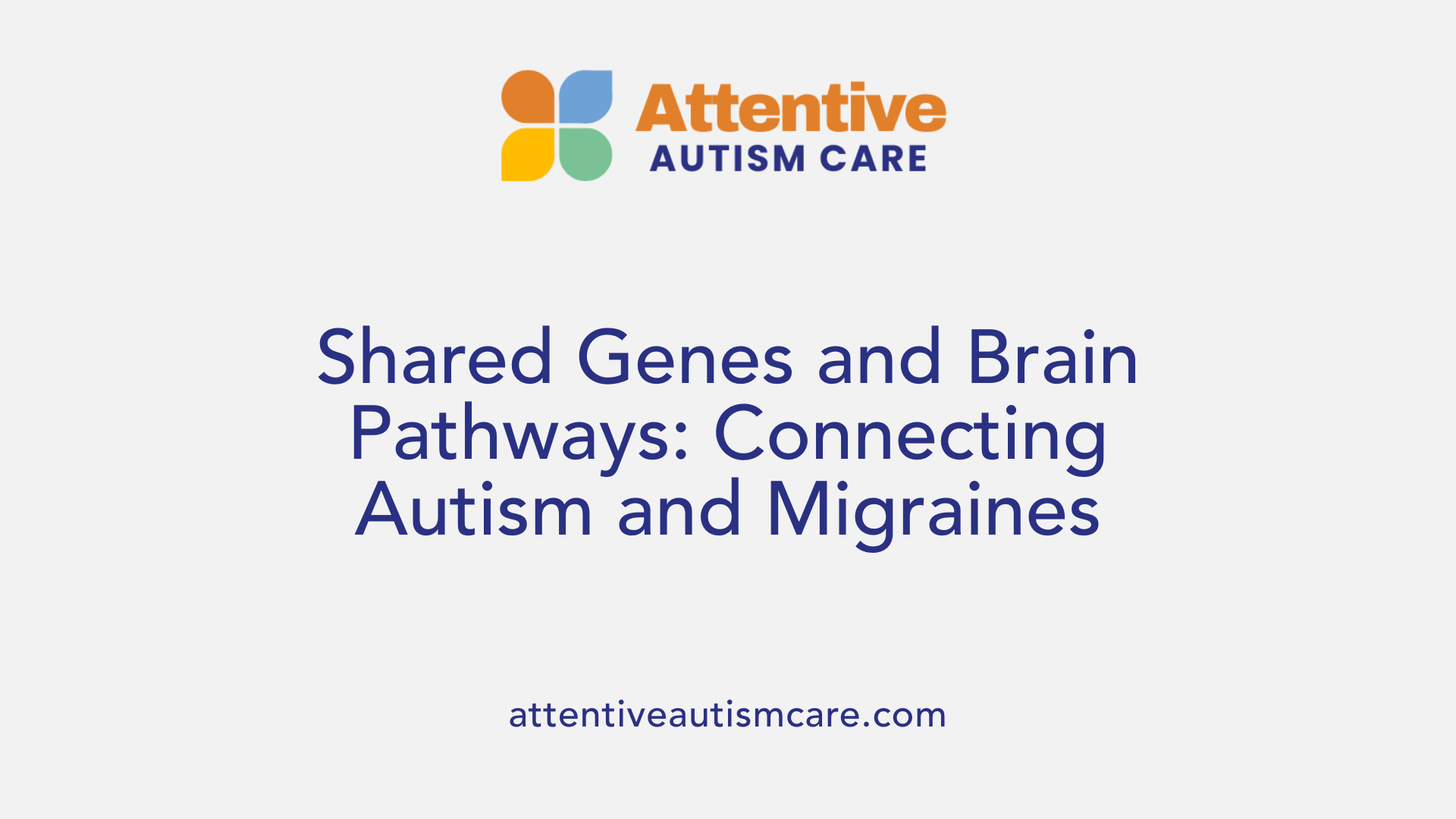
Are there shared underlying mechanisms between autism and migraines?
Research suggests that autism spectrum disorder (ASD) and migraines share several biological pathways and genetic factors, which may explain their frequent co-occurrence.
Genetic mutations, particularly those involving calcium channel genes such as CACNA1A, SCN1A, and ATP1A2, are common in both conditions. These genes are associated with channelopathies—abnormal functions of ion channels—that influence neural excitability and signaling. Studies show that mutations in these genes are linked with familial hemiplegic migraine, and these same genetic alterations have been observed in some individuals with ASD.
Neurochemical overlaps are also evident, notably involving serotonin and neuroinflammatory processes. Both conditions exhibit dysregulation of serotonin pathways, impacting mood, sensory processing, and pain regulation. Neuroinflammation, involving immune responses like mast cell activation and neuroimmune signaling, has been implicated in both autism and migraine pathology.
Alterations in brain connectivity and organization further link the two disorders. Imaging studies reveal atypical cortical architecture, such as minicolumn abnormalities, and disrupted thalamocortical circuits, affecting sensory integration and cortical excitability.
Neuroimmune responses and neurovascular regulation play crucial roles as well. Both conditions demonstrate abnormal neuroimmune activity and dysregulated blood flow in the brain, which may contribute to the heightened sensory sensitivities and pain experienced in autism and migraine attacks.
Genetic and molecular analyses from large population studies support these connections, showing shared genetic susceptibility and biological processes like neural development, immune response, and synaptic function. These shared mechanisms suggest that autism and migraines may be different manifestations of overlapping neurobiological abnormalities.
Understanding these common pathways provides insight into their co-occurrence and opens avenues for targeted treatments addressing the neurochemical, immune, and connectivity alterations underlying both conditions. It highlights the importance of multidisciplinary approaches to manage individuals affected by autism and migraines, considering their intertwined biological factors.
Neurochemical and Immune Factors in the Pathophysiology of Autism and Migraines
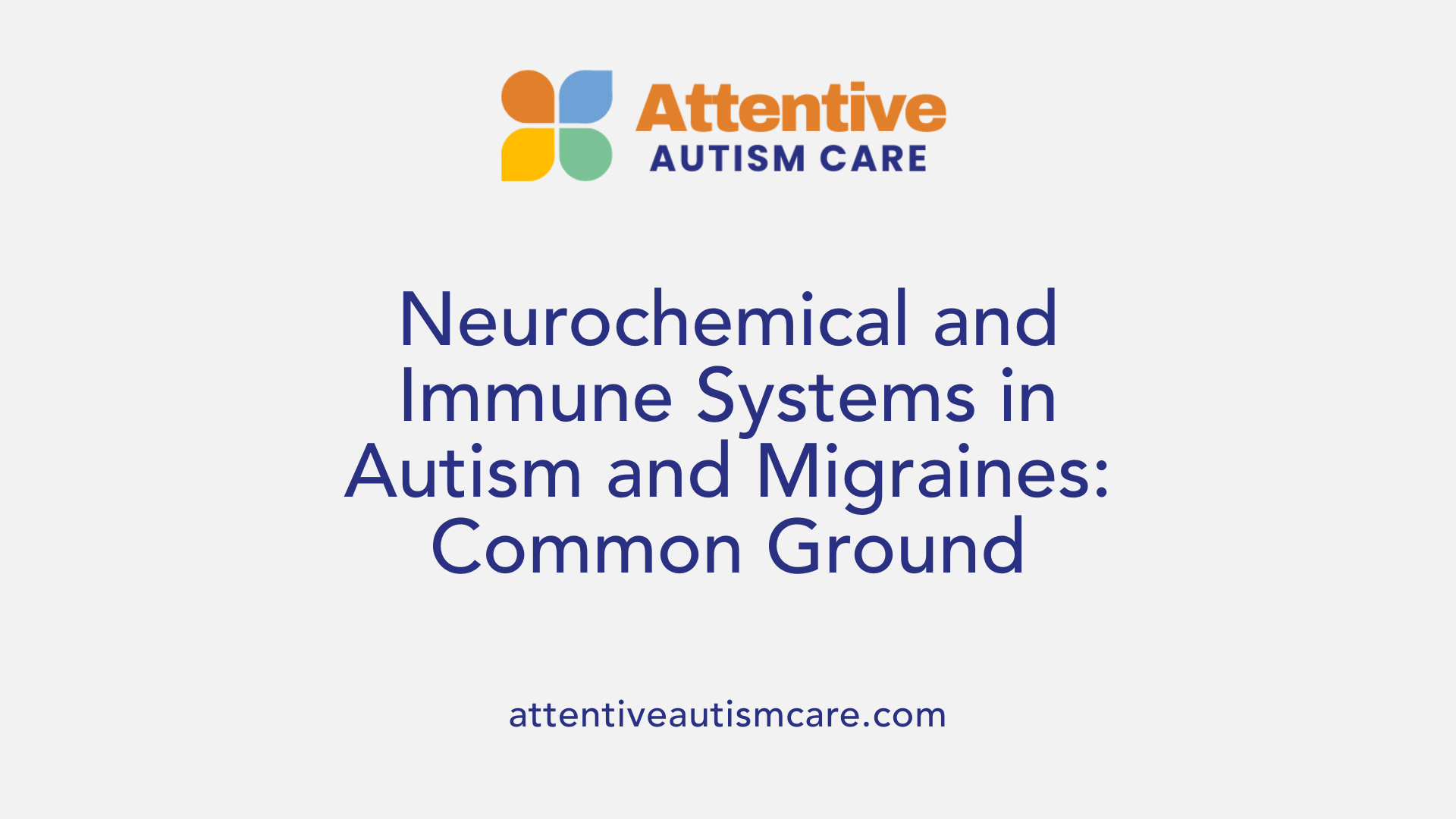
What are the common symptoms and clinical features of migraines in autistic individuals?
Autistic individuals experiencing migraines often show typical migraine symptoms like intense headache pain, nausea, vomiting, and increased sensitivity to light, sound, and touch. However, their sensory sensitivities can be more pronounced or atypical, making their experiences unique.
Many exhibit sensory hyperreactivity, especially to stimuli such as flashing lights or loud noises. These sensitivities not only act as triggers but can also worsen migraine episodes.
Behavioral changes, irritability, and sleep disturbances are common during migraines, adding complexity to their presentation.
Underlying biological factors, including altered serotonin systems, neuroinflammation, and differences in brain structure, may contribute to both migraine symptoms and the sensory processing differences in autism. Recognizing these overlapping features is vital for accurate diagnosis.
Addressing both the biological and sensory aspects helps in tailoring effective treatment strategies, improving quality of life for autistic individuals suffering from migraines.
| Symptom/Feature | Typical Occurrence in Autism | Notes |
|---|---|---|
| Headache pain | Common | Often reported as severe or persistent |
| Nausea and vomiting | Frequent | Can be exacerbated by sensory overload |
| Sensory sensitivities | Highly pronounced | Light, sound, touch, odors |
| Behavioral changes | Notable | Irritability, agitation, or withdrawal |
| Sleep disturbances | Common | Disrupted sleep patterns can trigger or worsen migraines |
| Trigger sensitivities | Heightened | Flickering lights, loud noises, strong odors |
Understanding the presentation and underlying biological links enhances diagnosis accuracy and promotes holistic management approaches for autistic individuals with migraines.
Sensory Processing and Neuropsychological Aspects of Autism and Migraine Co-occurrence
What are the common symptoms and clinical features of migraines in autistic individuals?
Autistic individuals suffering from migraines often display a range of typical symptoms, including intense head pain, nausea, vomiting, and a heightened sensitivity to light, sound, and touch. However, their sensory reactions may be more severe or atypical compared to neurotypical people. Many show sensory hyperreactivity, reacting strongly to visual stimuli like flickering lights or auditory inputs such as loud noises, which can serve as triggers for migraine attacks.
Behavioral changes during episodes—such as increased irritability, discomfort, or withdrawal—are also common. These symptoms can be further complicated by co-occurring conditions such as anxiety or sleep issues, making diagnosis more challenging. Underlying biological factors like disrupted serotonin systems, neuroinflammation, and brain structure differences contribute to the overlap in symptoms.
Understanding the interplay of these symptoms is vital for accurate diagnosis and tailored treatment strategies. Recognizing that sensory sensitivities can both precede and exacerbate migraine attacks aids healthcare providers in managing these complex cases more effectively.
Management Strategies for Migraines in Autistic Individuals
How can migraines in autistic individuals be managed or treated?
Managing migraines in autistic individuals involves a careful, personalized approach that accounts for their unique sensory sensitivities and communication styles. Recognizing and avoiding known triggers—such as bright lights, loud noises, certain scents, and irregular sleep patterns—is fundamental.
Pharmacological options should be chosen with caution and in collaboration with healthcare providers. Both acute treatments for immediate relief and preventive medications can be effective, but their selection must consider sensory preferences and possible side effects.
Behavioral therapies, including relaxation techniques like deep breathing and mindfulness, play a valuable role. Sensory management strategies, such as creating calm environments and using sensory tools, can help lessen overload and reduce the frequency of migraine attacks.
Environmental modifications—like dimming lights, reducing noise, and adjusting textures—support migraine prevention. Maintaining consistent daily routines for sleep, meals, and activities also helps stabilize the individual's system and minimize triggers.
Addressing co-occurring issues such as anxiety and sleep disorders is crucial, as these can exacerbate migraine symptoms. Adequate management of mental health and sleep hygiene can significantly decrease attack incidence.
Supporting caregivers with education and resources ensures that the management plan is sustainable and tailored to each person’s needs. Combining medical, behavioral, and environmental strategies offers the best chance of reducing the impact of migraines on autistic individuals' quality of life.
Supporting Caregivers and Individuals: Education and Practical Strategies
What should caregivers and individuals know about managing migraines in the context of autism?
Migraine is notably common among people with autism, especially in females, and can manifest with distinctive symptoms such as heightened sensitivity to light, sound, or touch, along with behaviors like head-banging and aura effects. Recognizing that sensory processing differences—like hypersensitivity—are integral to both autism and migraines can help in understanding triggers and symptoms.
Effective management begins with developing personalized plans in collaboration with healthcare providers. These involve identifying and avoiding individual triggers, which may include specific environmental stimuli, stress, or sleep disturbances. Medications and behavioral interventions can help reduce frequency and severity.
Educational advocacy is vital for minimizing the impact of migraines on daily life. Implementing accommodations such as flexible school hours or a 504 plan can support learning and participation. Additionally, strategies like environmental modifications—such as creating sensory-friendly spaces and controlling lighting or noise levels—are effective in reducing migraine attacks.
Since anxiety and neuroinflammatory processes often co-occur with autism and migraines, addressing mental health through counseling, relaxation techniques, and sensory regulation is crucial. Overall, a comprehensive, multidisciplinary approach that includes medical treatment, environmental adjustments, and emotional support offers the best chance for managing migraines effectively in autistic individuals.
Conclusion: Bridging the Gap in Understanding and Care
The association between autism and migraines underscores the need for increased awareness, tailored diagnostic approaches, and multidisciplinary management strategies. Recognizing shared neurobiological mechanisms, sensory sensitivities, and genetic predispositions can enhance clinical interventions and support for affected individuals. As research continues to unravel this complex relationship, fostering educational initiatives and caregiver support will be vital in improving quality of life for autistic people experiencing migraines, ultimately bridging the gap in understanding and effective healthcare.
References
- Autism and Migraine: An Unexplored Association? - PubMed Central
- Autism and migraine: Link and possible causes - Medical News Today
- Autism and Migraine: A Narrative Review - PMC - PubMed Central
- Autism and Migraines: Is There a Connection? - APM
- Autism Spectrum Disorder and Migraines
- How My Autism Diagnosis Helps Me Manage My Migraine
- What You Should Know about Autistic Burnout and Migraines
- with and without aura are associated with polygenic scores for autism
- Autism and Migraine: An Unexplored Association? - PubMed Central

















































































